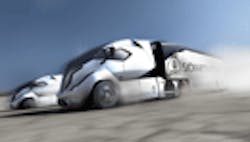Class 8 highway tractors will need to be ‘re-packaged’ in order to reduce weight, boost efficiency and increase productivity to meet 2014 fuel economy standards, according to truck designers.
“We’re looking at what we call ‘big picture’ ideas concerning vehicle weight, size, and shape,” Mark West, professor of transportation design at the Detroit, MI-based College for Creative Studies (CCS), told Fleet Owner.
“Even if by changing the vehicle’s shape you gain 1/10th of a mile per gallon more in fuel economy, it’s transformative – especially in terms of fuel prices today,” he explained. “Yet it all must be based in the real world, using existing materials to keep cost of production down. That’s why we use the term ‘re-packaging. We’re trying to end up with a vehicle that fits the same shape as today’s models, yet that’s more capable, especially in terms of fuel savings.”
A private, fully accredited college, CCS enrolls 1,400 students pursuing Master of Fine Arts and Bachelor of Fine Arts degrees.
West said CCS has spent the last three years carving out a mini department within its transportation design wing to focus exclusively on long-haul trucks. With financial sponsorship from Meritor Inc. and Navistar, 15 of CCS’s students have focused on ways to re-shape current truck designs in order to meet ambitious federal government mandates that slash heavy-truck fuel consumption and emissions by some 10% to 20%.
“The new government regulations will change the way companies make trucks,” West noted. “That’s why our designers must look at the entire picture when designing a vehicle now, not just the aesthetics. [We must address] fuel efficiency, sustainability/recycling, and aerodynamic issues.”
For example, one of West’s students experimented with shortening the hood on a conventional tractor, moving the engine farther back over the steer axle. Not only did this reduce the surface area of the truck, thus lowering aerodynamic drag and improving fuel economy, but positioning the engine this way allowed for weight reductions as less frame support for the engine was needed. This further added to fuel efficiency gains.
“Creating a ‘mid design’ engine eliminated materials previously needed to enhance chassis rigidity,” West noted. “That’s how ‘repackaging’ the truck within the same space can produce the fuel economy gains OEMs and fleets are seeking.”
He stressed that current and future truck designs must also maintain visual and functional appeal to the drivers operating them, whether those drivers are rookies or veterans.
“We thought fleets would be all about fuel efficiency and weight. To our surprise, truck design is one of their top priorities because the truck is used as part of their driver retention programs,” West said. “So our students had to make sure to work a certain amount of ‘bling’ as well comfort into their designs.”
A big challenge, he added, is to create designs that attract younger drivers into the industry yet, at the same, time keep older drivers happy. On top of that, students must also incorporate the vehicle’s
life expectancy, hybrid powertrains, integrated solar panels, and highway safety features, as well as the driver comfort and serviceability issues.
“In many ways, this means taking a ‘holistic’ view of the truck and how to take all of these different – and sometimes conflicting – needs and meet them with one package,” he said. “That’s the problem our students, the truck designers of the future, are trying to solve right now.”
About the Author
Sean Kilcarr
Editor in Chief
Sean Kilcarr is a former longtime FleetOwner senior editor who wrote for the publication from 2000 to 2018. He served as editor-in-chief from 2017 to 2018.
